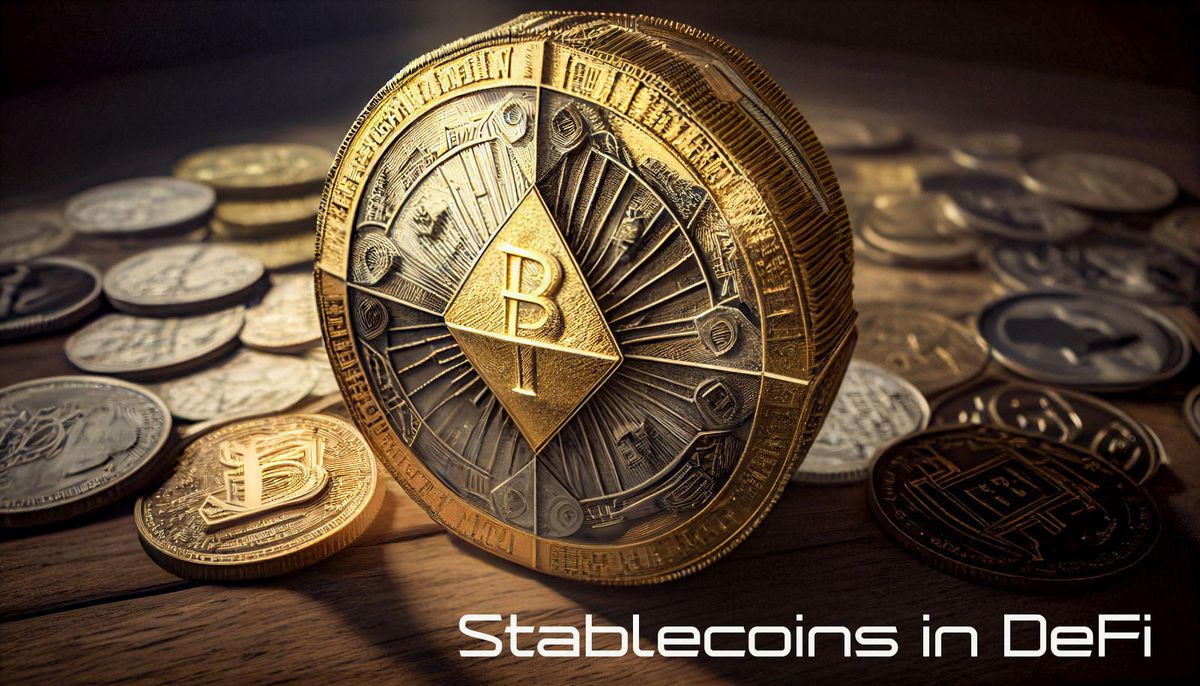Stablecoins in Decentralized Finance: Stability Amidst Volatility

The decentralized finance (DeFi) ecosystem has witnessed rapid growth and innovation in recent years, offering users a plethora of financial services without the need for traditional intermediaries. However, the inherent volatility of cryptocurrencies can pose challenges for those seeking stability within the DeFi space. To address this issue, stablecoins have emerged as a critical component of the DeFi ecosystem, providing a stable store of value and serving as a crucial medium of exchange.
In this article, we will delve into the role and benefits of stablecoins in decentralized finance, exploring how they help reduce volatility and facilitate efficient financial operations. We will begin by providing an overview of stablecoins, discussing their different types and popular examples. Subsequently, we will examine the integration of stablecoins into DeFi platforms and their various use cases, such as lending, borrowing, and decentralized exchanges. Furthermore, we will outline the challenges stablecoins face, including regulatory, legal, and transparency concerns, and assess their future outlook in the context of the DeFi ecosystem.
By understanding the significance of stablecoins in decentralized finance, users and investors can better navigate the DeFi landscape and capitalize on the stability and opportunities that stablecoins provide amidst the inherent volatility of cryptocurrencies.
Understanding Stablecoins
Stablecoins are a type of cryptocurrency designed to maintain a stable value by pegging their price to a reserve of assets, typically a fiat currency like the US dollar or a basket of assets. Unlike traditional cryptocurrencies, stablecoins aim to minimize price fluctuations and provide users with a reliable medium of exchange and store of value within the crypto ecosystem.
Types of stablecoins
There are three main types of stablecoins, each with distinct collateralization mechanisms:
- Fiat-collateralized stablecoins: These stablecoins are backed by a reserve of fiat currency, usually held by a third party or custodian. For every stablecoin issued, an equivalent amount of fiat currency is held in reserve, ensuring the stablecoin's value remains pegged to the underlying asset. Examples of fiat-collateralized stablecoins include Tether (USDT) and USD Coin (USDC).
- Crypto-collateralized stablecoins: Instead of being backed by fiat currency, these stablecoins are collateralized by other cryptocurrencies. Due to the volatile nature of cryptocurrencies, over-collateralization is often required to maintain price stability. A popular example of a crypto-collateralized stablecoin is DAI, which is backed by a basket of cryptocurrencies, primarily Ethereum.
- Algorithmic stablecoins: These stablecoins do not rely on collateralization but instead use algorithms and smart contracts to maintain price stability. By adjusting the supply of the stablecoin in response to market demand, algorithmic stablecoins aim to maintain their peg to the underlying asset. Examples of algorithmic stablecoins include Ampleforth (AMPL) and TerraUSD (UST).
Popular stablecoins
- Tether (USDT): Launched in 2014, Tether is the largest fiat-collateralized stablecoin, with its value pegged to the US dollar. It is widely used in the crypto ecosystem for trading and settling transactions, offering users a stable alternative to volatile cryptocurrencies. Market Cap - $80.24 Billions.
- USD Coin (USDC): Developed by the Centre Consortium, a collaboration between Circle and Coinbase, USDC is another prominent fiat-collateralized stablecoin. It maintains a 1:1 peg to the US dollar and is fully redeemable for the underlying asset. Market Cap - $32.57 Billions.
- DAI: Created by MakerDAO, DAI is a decentralized, crypto-collateralized stablecoin pegged to the US dollar. It allows users to generate DAI by depositing collateral (mainly Ethereum) into Maker smart contracts, offering a stable and decentralized alternative to fiat-collateralized stablecoins. Market Cap - $5.26 Billions.
Stablecoins in the DeFi Ecosystem
A. Integration of stablecoins into DeFi platforms
Stablecoins have become an integral part of the DeFi ecosystem, offering a stable medium of exchange and store of value in various decentralized applications. Due to their low volatility and ease of use, stablecoins are often the preferred choice for users engaging with DeFi platforms.
B. Role of stablecoins in lending and borrowing
In the DeFi lending and borrowing space, stablecoins play a crucial role by providing a stable asset that users can lend or borrow without worrying about significant price fluctuations. Platforms like Aave, Compound, and MakerDAO have integrated stablecoins such as DAI, USDT, and USDC, allowing users to earn interest on their deposits or access credit through collateralized loans.
C. Stablecoins in decentralized exchanges (DEXs) and liquidity pools
Decentralized exchanges (DEXs) like Uniswap, SushiSwap, and Curve have also embraced stablecoins, enabling users to trade them against other cryptocurrencies or provide liquidity to stablecoin-based liquidity pools. By participating in these liquidity pools, users can earn trading fees and additional incentives in the form of governance tokens. Stablecoin-based liquidity pools are particularly popular due to their low price volatility and reduced risk of impermanent loss.
D. Stablecoins in yield farming and staking
Yield farming, a popular DeFi strategy, often involves stablecoins as they allow users to earn passive income with relatively lower risks. Users can deposit or stake their stablecoins in various DeFi platforms to earn interest, governance tokens, or other rewards. Some platforms, like Yearn Finance and Harvest Finance, have specifically designed yield farming strategies for stablecoin holders, optimizing their returns across different DeFi platforms.
Stablecoins have become an essential element of the DeFi ecosystem, providing stability and usability in various applications, such as lending, borrowing, trading, and yield farming. Their low volatility and ease of use make them an attractive option for both newcomers and experienced users, helping to drive the growth and adoption of decentralized finance.
IV. Benefits of Stablecoins in DeFi
A. Reducing volatility and providing a stable store of value
One of the main benefits of stablecoins in the DeFi ecosystem is their ability to provide a stable store of value amidst the volatility of cryptocurrencies. Users can hedge against price fluctuations and preserve their capital by converting their assets to stablecoins, mitigating the risk associated with sudden market movements.
B. Facilitating cross-border transactions and remittances
Stablecoins enable fast, low-cost, and secure cross-border transactions and remittances. By pegging their value to a stable asset, such as a fiat currency, stablecoins offer a convenient and reliable medium of exchange for international transactions without the need for traditional intermediaries, such as banks or money transfer services.
C. Enhancing the efficiency of decentralized finance operations
Stablecoins help improve the efficiency of various DeFi operations, such as lending, borrowing, and trading. By providing a stable medium of exchange, stablecoins enable users to confidently engage in financial activities without worrying about the impact of price fluctuations on their investments or transactions. This stability can contribute to the overall growth and adoption of DeFi platforms and services.
D. Attracting new users to the DeFi ecosystem
The stability and usability of stablecoins make them an appealing entry point for newcomers to the DeFi ecosystem. By offering a familiar and stable asset, stablecoins can help reduce the learning curve and perceived risks associated with decentralized finance, attracting a wider audience and fostering greater adoption.
In summary, stablecoins play a crucial role in the DeFi ecosystem, offering numerous benefits such as reducing volatility, facilitating cross-border transactions, enhancing the efficiency of DeFi operations, and attracting new users. By providing a stable and accessible medium of exchange, stablecoins contribute to the growth, sustainability, and mainstream adoption of decentralized finance.
Challenges for Stablecoins in DeFi
One of the main challenges for stablecoins in the DeFi ecosystem is the evolving regulatory and legal landscape. Governments and regulatory bodies are increasingly scrutinizing stablecoins, particularly those pegged to fiat currencies, due to concerns related to money laundering, tax evasion, and financial stability. As a result, stablecoin issuers and DeFi platforms may face increased compliance requirements, which could impact their operations and adoption.
Ensuring transparency and trust in collateralization mechanisms
Transparency and trust are essential for the success of stablecoins, particularly those backed by collateral. Users need to trust that the underlying assets backing the stablecoins are securely held and can be redeemed if necessary. However, some stablecoin issuers have faced criticism for their lack of transparency and audits, raising concerns about the actual collateralization levels and the potential for fraud or mismanagement.
Managing risks associated with centralized stablecoins
Centralized stablecoins, such as those backed by fiat currencies, pose unique risks within the DeFi ecosystem. The reliance on a central authority or custodian to manage the collateral raises concerns about counterparty risk, potential censorship, and single points of failure. Decentralized stablecoins, such as DAI, offer a more trustless alternative but may still be exposed to risks associated with the underlying collateral or smart contract vulnerabilities.
Environmental concerns surrounding stablecoin creation and trading
As with other cryptocurrencies, stablecoin creation and trading can have environmental implications due to the energy-intensive nature of blockchain technology. While some blockchain networks are transitioning to more sustainable consensus mechanisms, such as proof-of-stake, the environmental impact of stablecoins remains a concern for some users and stakeholders.
While stablecoins offer numerous benefits within the DeFi ecosystem, they also face several challenges, including regulatory and legal considerations, transparency and trust issues, risks associated with centralization, and environmental concerns. Addressing these challenges will be crucial for the long-term success and adoption of stablecoins in decentralized finance.
Future Outlook for Stablecoins in DeFi
A. The potential for stablecoins to become a cornerstone of the DeFi ecosystem
As DeFi continues to mature and expand, stablecoins are poised to play an even more significant role in the ecosystem. By addressing the challenges they currently face and continually improving their offerings, stablecoins have the potential to become a cornerstone of the DeFi landscape, providing stability, usability, and accessibility for a broad range of users.
B. Emerging trends and developments in the stablecoin space
In response to the growing demand for stablecoins, new projects and innovations are emerging to address the needs of the DeFi community. Some of these developments include the creation of new types of stablecoins, such as those backed by real-world assets or commodities, as well as the development of decentralized stablecoin issuance platforms that leverage smart contracts and decentralized governance.
Additionally, the adoption of Layer 2 scaling solutions and cross-chain interoperability is expected to enhance the efficiency and usability of stablecoins within the DeFi ecosystem, facilitating faster transactions and lower fees.
C. Integration of stablecoins with Central Bank Digital Currencies (CBDCs)
As central banks around the world explore the development and implementation of Central Bank Digital Currencies (CBDCs), stablecoins may play a crucial role in the integration of CBDCs within the DeFi ecosystem. By serving as a bridge between CBDCs and decentralized finance, stablecoins could facilitate seamless interaction between traditional financial systems and DeFi, fostering greater collaboration and innovation across the financial sector.
Conclusion
In conclusion, stablecoins play a critical role in the DeFi ecosystem, providing stability and usability in a variety of applications and use cases. By addressing the challenges they currently face and capitalizing on emerging trends and developments, stablecoins have the potential to contribute significantly to the broader adoption and success of decentralized finance.
As the DeFi landscape continues to evolve, stablecoins are poised to become an even more essential component of the ecosystem, offering users a stable and accessible medium of exchange that bridges the gap between traditional finance and decentralized solutions. By harnessing the power of stablecoins, DeFi can continue to grow and thrive, delivering innovative financial services and opportunities to users around the world.
Please share your thoughts on the article by clicking below Emoji ...
Disclosure
*The information provided on this cryptocurrency blog is for educational and informational purposes only and should not be construed as financial, investment, or trading advice. The authors, contributors, and administrators of this blog are not licensed financial professionals and do not hold any formal qualifications in the fields of finance, economics, or cryptocurrencies.
The content on this blog is based on the authors' personal opinions, experiences, and research, and should not be considered as professional financial guidance. While we strive to provide accurate, up-to-date, and reliable information, we cannot guarantee the accuracy or completeness of the information presented. Cryptocurrency markets are highly volatile, and investments in cryptocurrencies and related assets carry a substantial risk of loss.
Before making any financial decisions or investments, you should consult with a qualified financial advisor or perform your own research and analysis. Any actions taken based on the information provided on this blog are at your own risk, and the authors, contributors, and administrators of this blog cannot be held liable for any losses or damages resulting from the use of the information found herein.
By using this blog, you acknowledge that you have read and understood this disclosure and agree to assume full responsibility for any decisions or actions you take based on the information provided.*



